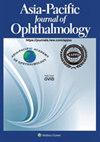Trends and projections of the burden of visual impairment in Asia: Findings from the Global Burden of Disease Study 2021
IF 4.5
3区 医学
Q1 OPHTHALMOLOGY
引用次数: 0
Abstract
Purpose
This study aims to examine the trends in the burden of visual impairment across Asia from 1990 to 2021 and to project the burden through 2040.
Methods
This population-based study used data from the latest Global Burden of Disease 2021 study. Prevalence and years lived with disability (YLDs) were the main outcomes. The trends were analyzed by calculating the average annual percentage change (AAPC) using joinpoint regression analysis. The projection was performed by Bayesian age-period-cohort modeling.
Results
The prevalence of visual impairment in Asia increased from 1990 to 2021, with AAPCs of 0.77 (95 % confidence interval [CI], 0.44–1.11), while YLD rates decreased with AAPCs of − 0.21 (95 % CI, − 0.38 to − 0.03). Near vision loss was the main contributor to visual impairment in Asia. Notably, the prevalence in the working-age population (20–54 years) increased significantly from 1990 to 2021 (AAPC = 2.11 [95 % CI, 1.70–2.53]), which was accord with the YLDs (AAPC = 1.07 [95 % CI, 0.83–1.32]), whereas for children and adolescents (< 20 years) and the elderly (≥ 55 years) it has decreased. According to the projection, the burden was predicted to significantly increase across all Asian sub-regions, especially in East Asia and South Asia.
Conclusion
The burden of visual impairment in Asia has been substantially increasing from 1990 to 2021. This trend is anticipated to persist significantly soon, especially in East Asia and South Asia, underlining the urgent need for concentrated attention and robust policy support for these regions.
亚洲视力损伤负担的趋势和预测:2021 年全球疾病负担研究的结果。
目的:本研究旨在研究1990年至2021年亚洲视力障碍负担的趋势,并预测到2040年的负担。方法:这项基于人群的研究使用了最新的2021年全球疾病负担研究的数据。患病率和残疾生活年数(YLDs)是主要结果。采用连接点回归分析计算年平均百分比变化(AAPC),分析其变化趋势。通过贝叶斯年龄-时期-队列模型进行预测。结果:从1990年到2021年,亚洲视力障碍患病率上升,AAPCs为0.77(95%可信区间[CI], 0.44至1.11),而YLD发生率下降,AAPCs为-0.21 (95% CI, -0.38至-0.03)。在亚洲,近视力丧失是造成视力损害的主要原因。值得注意的是,从1990年到2021年,工作年龄人口(20至54岁)的患病率显著增加(AAPC = 2.11 [95% CI, 1.70至2.53]),这与YLDs一致(AAPC = 1.07 [95% CI, 0.83至1.32]),而儿童和青少年(结论:1990年至2021年,亚洲视力障碍负担大幅增加)。预计这一趋势将很快持续下去,特别是在东亚和南亚,这突出表明迫切需要对这些区域给予集中关注和强有力的政策支持。
本文章由计算机程序翻译,如有差异,请以英文原文为准。
求助全文
约1分钟内获得全文
求助全文
来源期刊

Asia-Pacific Journal of Ophthalmology
OPHTHALMOLOGY-
CiteScore
8.10
自引率
18.20%
发文量
197
审稿时长
6 weeks
期刊介绍:
The Asia-Pacific Journal of Ophthalmology, a bimonthly, peer-reviewed online scientific publication, is an official publication of the Asia-Pacific Academy of Ophthalmology (APAO), a supranational organization which is committed to research, training, learning, publication and knowledge and skill transfers in ophthalmology and visual sciences. The Asia-Pacific Journal of Ophthalmology welcomes review articles on currently hot topics, original, previously unpublished manuscripts describing clinical investigations, clinical observations and clinically relevant laboratory investigations, as well as .perspectives containing personal viewpoints on topics with broad interests. Editorials are published by invitation only. Case reports are generally not considered. The Asia-Pacific Journal of Ophthalmology covers 16 subspecialties and is freely circulated among individual members of the APAO’s member societies, which amounts to a potential readership of over 50,000.
 求助内容:
求助内容: 应助结果提醒方式:
应助结果提醒方式:


